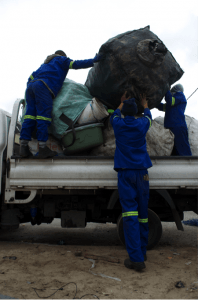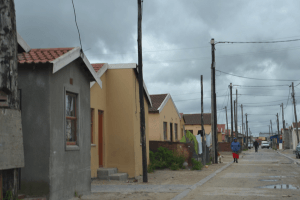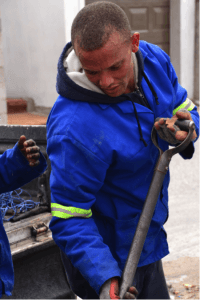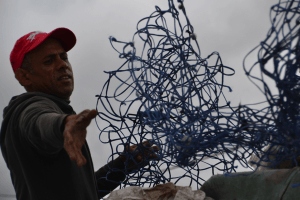Scene 3: A Day in the Field
As team leader, John took Archit and Brendan out for a pickup while Steve and Kelsey rode with Peter, one of the Blue Sky drivers. Japie remained back at the Blue Sky facility to sort while the rest of us rode out with the employees and drivers to bring a load back for sorting.
Setting:
As we rode into the informal settlements, the scenery drastically changed from modern-looking houses to shacks built in very close quarters to one another. Driving down the streets it was clear that the living conditions were much harsher in these areas as we heard emaciated dogs barking, children playing in trash ridden streets, and shacks covered with holes. The roads, if paved, were littered with potholes but most were dirt roads too narrow for a large truck to pass an oncoming vehicle. The stench of waste could be smelled from inside the truck as we were bouncing up and down along the holes in the road. Though the settlement appeared gloomy, it was both refreshing and inspiring to see the pleasant expressions of the pickers as they greeted John and the Blue Sky team upon arrival at their residencies.
Planning:
In setting out to observe Blue Sky’s pickup processes, our group hoped to develop a better understanding of:
- How do the pickers organize their recycling at home?
- How do the workers load the trucks during pickup?
- How do the workers determine the payment received by each picker?
- How does Blue Sky keep track of payments and pickups?
- What additional tasks must be done during pickup by the employees or pickers?
- How long do pickups take and what aspects could be run more efficiently?
Action and Observation:
With all of these questions in mind, our team kept a keen eye on the Blue Sky workers and took pictures throughout the day. We were able to answer all of our questions through interactions with both the employees and the community members. When we arrived at the first residency, the picker was not home and we were forced to move on to the next stop. At the second stop, we were again disappointed as the picker had not collected enough materials for the pickup to be worthwhile. The third picker was at work and Blue Sky was unable to collect her bags of recyclables. It was not until the fourth location that we were able to begin observing the pickup process currently in place. The frustration was apparent on the faces of the Blue Sky workers as they were wasting time during their day traveling to pickers’ homes who were unavailable or not ready for pickup. Adding to the frustration, the language barrier between the pickers and the Blue Sky employees was obvious, creating distinct obstacles in terms of payment, database information, and even pickup information for the future regarding sorting. This was illustrated as some of the pickers had their recycling piled up with absolutely no attention to material separation. These residencies proved to take significantly longer to load because some on-site sorting is required. In some cases, our group noticed that it could take up to twice or even three times as long to pick up a load that was not categorized prior to arrival, creating a substantial amount of work for the Blue Sky workers.
At each residency that Blue Sky collected from, we watched the entire process from the beginning as the workers would first crush and load the cullet glass, or broken glass. The glass would be stored in a large bag or container wherein the workers would smash it into smaller pieces with a shovel, haul the pieces into a trash can, and weigh the full container before dumping each of these smaller loads into a larger bag waiting on the truck. During this process, other workers were sorting through the full bottles to separate the returnable bottles from nonreturnable bottles which are valued at different rates. Once all of the glass products were sorted, the Blue Sky team got to work on the remaining recyclables. For the most part, this includes plastics, paper, cardboard, and cans, with an assortment of random appliances and the like thrown in at times. Each of the bags containing this recycling is weighed on an electronic scale and added to the pile on the truck that is stacked high above the cab of the truck itself. A net is then thrown over the pile of bags to keep everything in place so the materials are transported safely back to Blue Sky.
Once there, further sorting and storage will occur before the materials are brought to another supplier. The day was long as we travelled to many pickers’ homes before having a full load to return to Blue Sky with. It is important that the trucks are loaded to maximum capacity without exceeding the weight limit in order to achieve maximum efficiency. On days like this however, the volume of recycling exceeds the trailer space before the weight limit is reached, lowering efficiency as money is being made per weight amount as opposed to quantity. John discussed the importance of filling the trailer to the maximum weight capacity with our group, saying that the team does not always do this when he is not present. This discrepancy causes them to fall short of monthly target goals. Overall, the day was extremely helpful and descriptive in showing the exact process and steps that go into recycling pickup at Blue Sky. From this primary experience, our team observed areas of opportunity for improved methods.

Reflection and Learning:
Looking back on the pickups that we witnessed today, our group saw the compassion that John shares for the community first-hand as we witnessed his interactions with the customers. Although there is a clear language barrier between John and the pickers, they demonstrate affection for John by welcoming him warmly upon arrival,. We noted that even the occasional passerby that would excitedly greet him on the streets. John treats the pickers like family as he goes to each home to collect their recyclables, attempting to give them the most money for their goods, and acting with courtesy and respect towards each and every one. Additionally, we watched as the Blue Sky employees continued to work through the rainy weather in order to make sure all of the customers in the surrounding area were reached. We were shocked by the personal connection that Blue Sky shares with their customers. They truly do not operate like a business but more like a family to the surrounding community.
Even more surprising than the workers’ compassion was the behaviours of the pickers. When our group was seen walking through the streets of the informal settlements, we were graciously welcomed into homes while pickers would describe their experiences and processes with us. The children in the communities loved getting their pictures taken and talking with us.We were pleasantly surprised by all of the warmth that was offered by the pickers who were all excited to see us. The unique relationship between the pickers and Blue Sky clearly demonstrates the workings of a tightknit community working together towards a common goal.
Notes for the Future Scenes:
Our tour with the Blue Sky Recycling Team set our group up for future progress. Our group now understands the inner workings of Blue Sky, allowing us to see the areas for opportunity of growth. Additionally, by interviewing various pickers, we are able to see the needs of the pickers and how we can potentially help them be successful. It will be important to collaborate closely with Blue Sky and the pickers throughout the coming weeks in order to establish what the needs are and how our group will be able to contribute. This tour has allowed us to elaborate upon these observations and give us a stepping stone to further our progress.







